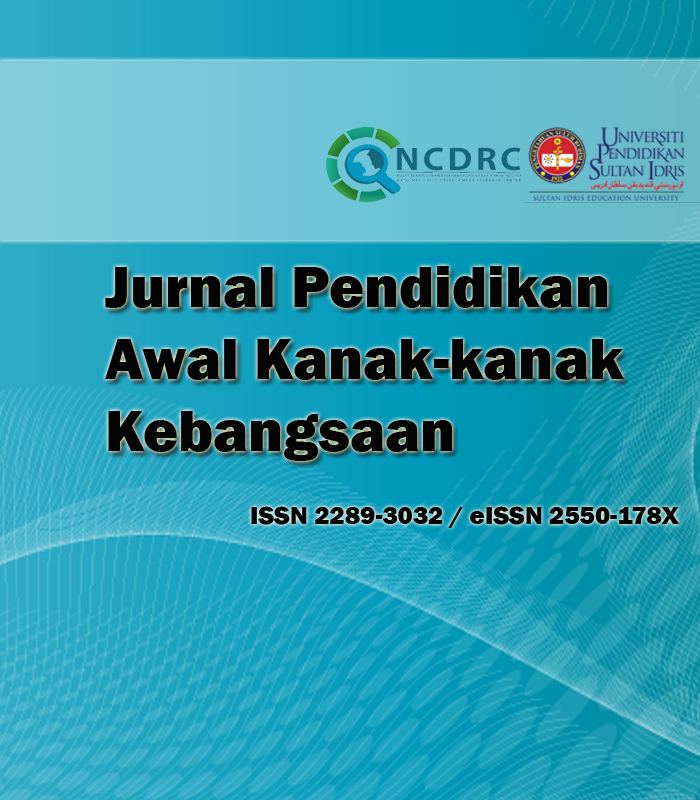Achieving Quality Learning Through STEM Education Towards Kindergarten Teachers’ Perceptions
DOI:
https://doi.org/10.37134/jpak.vol11.1.10.2022Keywords:
STEM Education, 21st Century Learning, Quality Learning, Best PracticeAbstract
STEM Education is one of the elements that need to be applied in 21st Century Education (PAK- 21). However, STEM Education is given less attention by many early childhood education (ECE) teachers due to various factors that influence its implementation in kindergartens such as lack of exposure to STEM Education information and many more. This study was conducted to see the perceptions of kindergarten teachers on how they think about the importance of STEM Education itself in order to ensure the quality of children's learning can be achieved through STEM Education at the early schooling level. The objectives of this study are (i) to explore the best practices of teaching STEM Education; (ii) to explore the accessibility of informative knowledge through STEM education; (iii) to explore the integration of STEM disciplines in STEM activities; and (iv) to explore the implementation of STEM activities in teaching and learning sessions. There were 4 participants selected in this study and they were kindergarten teachers with different backgrounds. Besides that, a set of interview protocols was used as an instrument in this study containing 16 questions. Data were analyzed using NVIVO software version 10. The findings of the study found that there are various methods, strategies, techniques, and creative teaching methods that can be used in STEM education because it will provide quality learning to children holistically. In line with the agenda of the Ministry of Education Malaysia in elevating STEM Education, it is hoped that the study will be a reference for ECE teachers.
Downloads
References
Barnett, M. (2005). Engaging inner city students in learning through designing remote operated vehicles. Journal of Science Education & Technology, 14(1), 87–100.
Breiner, J. M., Harkness, S. S., Johnson, C. C., & Koehler, C. M. (2012). What is STEM? A discussion about conceptions of STEM in education and partnerships. School Science and Mathematics, 112(1), 3-11.
Cherry, K. (2014). Piaget’s Stages of Cognitive Development. Retrieved on May 23, 2021 from http://psychology.about.com/od/piagets theory/a/keyconcepts.htm
Crossman, A. (2020). An Overview of Qualitative Research Methods. Retrieved on December 26, 2020 from https://www.thoughtco.com/qualitative-research-methods-3026555
Daud, S. (2019). The challenges of preschool teachers in implementing STEM education.
Journal of Science & Mathematics Education Malaysia 9(2), 25-34.
Etikan, I. l., Musa, S. A., & Alkassim, R. S. (2016). Comparison of convenience sampling and purposive sampling. American Journal of Theoretical and Applied Statistics, 5(1), 1-4.
Furner, J. and Kumar, D. (2007). The Mathematics and Science integration argument: A stand for teacher education. Eurasia Journal of Mathematics, Science & Technology Education, 3(3), 185-189.
Gervasoni, A., Giumelli, K., & McHugh, B. (2017). The development of addition and subtraction strategies for children in kindergarten to Grade 6: Insights and implications. In A. Downton, S. Livy, & J. Hall (Eds.), 40 years on: We are still learning! Proceedings of the 40th Annual Conference of the Mathematics Education Research Group of Australasia
(pp. 269-276). Melbourne: MERGA.
Lopez, J., & Whittington, M. S. (2001). Higher-Order Thinking in a College Couse: A Case Study.
NACTAJOURNAL, 45(4), 22-29.
Khalik, M., Talib, C. A., Aliyu, H., Ali, M., Samsudin, M. A. (2019). Dominant instructional practices and their challenges of implementation in integrated stem education: A systematic review with the way forward. Learning Science and Mathematics, 14, 92- 106.
Manning, M., Homel, R., & Smith, C. (2010). A meta-analysis of the effects of early developmental prevention programs in at-risk populations on non-health outcomes in adolescence. Children and Youth Services Review, 32(4), 506-519.
Magaldi, D., & Berler, M. (2018). Semi-structured Interviews. In: Zeigler-Hi, V., Shackelford, T. (eds). Encyclopedia of Personality and Individual Differences. Springer, Chan. Retrieved on 22, February, 2020 from https://doi.org/10.1.1007/978-3-319-28099-8_857-1
Minarni, A., Napitupulu, E., & Husein, R. (2016). Mathematical understanding and representation ability of public junior high school in North Sumatra. Journal on Mathematics Education, 7(1), 3-56.
McClure, E., Guernsey, L., Clements, D., Bales, S., Nichols, J., Kendall-Taylor, N., et al. (2017). STEM Starts Early: Grounding Science, Technology, Engineering, And Math Education in Early Childhood. New York: The Joan Ganz Cooney Center at Sesame Workshop.
Ministry of Education of Malaysia (2013). Malaysia Education Blueprint 2013 – 2015 (Pre School
– Post- Secondary Education). Putrajaya, Malaysia: Ministry of Education.
Nadelson, L. S., & Seifert, A. L. (2017). Integrated STEM defined: Context, challenges, and the future. The Journal
of Educational Research, 110(3), 221-223.
National Academy of Engineering (NAE) and National Research Council (NRC). (2014). STEM Integration in K-12 education: Status, Prospects, and an Agenda for Research. Committee on Integrated STEM Education. Washington, D.C: The National Academies Press.
Open Learn Create (OLC). (2020). Purpose of teaching and learning materials. Retrieved on July 5th 2021 from https://www.open.edu/openlearncreate/mod/page/view.php?id=168509
Samian, S., & Awang, A. (2017). Education as quality components of life in the suburban community. Asian Journal of Environment, History and Heritage, 1(1), 267-280.
Sobey, N. (2019). Does Working in Collaborative Groups to Complete STEM Design Challenges Increase Student Engagement Among Preschool-aged Children? (Doctoral dissertation, Hofstra University).
Tan, C., T. (2017). Enhancing The Quality of Kindergarten Education in Singapore: Policies And Strategies in The 21st Century. International Journal of Child Care and Education Policy, 11(7)
Wallerstedt, C., & Pramling, N. (2012). Learning to play in a goal-directed practice. Early Years 32(1), 1-11.DOI:10.1080/09575146.2011.593028
Wang, H., Moore, T., Roehrig, G. & Park, M. S. (2011). STEM Integration: Teacher perceptions and practice. Journal of Pre-College Engineering Education Research, 1(2), 1–13.
Downloads
Published
Issue
Section
License
Copyright (c) 2022 Muhammad Nur Azam Bin Ghazali, Muhammed Yusuf

This work is licensed under a Creative Commons Attribution-NonCommercial-ShareAlike 4.0 International License.





